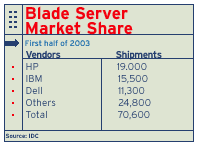IBM To Unveil PowerBlades And Chassis
Solution providers welcomed the move, saying the servers will allow them to transition legacy pSeries customers to a blade architecture and consolidate multiplatform applications into a single rack enclosure.
An IBM spokesperson confirmed the plan, adding that the new blades, called PowerBlades, will run on the company's Power4 processor, with Power5 versions becoming available when the new chip is released next year.

IBM is also designing a new blade server chassis that will allow the PowerBlades to be mixed and matched with its current BladeCenter x86-based server blades.
Mitch Kleinman, executive vice president and general manager at Computer Configuration Services, an IBM solution provider in Irvine, Calif., said the PowerBlades will be "fantastic for anyone doing Linux consolidation in the Web world."
Linux runs on both xSeries and pSeries, and mixing the two types of blades will allow customers to run Windows, AIX and Linux applications from the same chassis, he said.
Kleinman also is looking forward to the opportunity to move existing pSeries and RS/6000 customers to a blade infrastructure. "Those customers [running older RS/6000 technology] don't want to be on the same systems," he said. "Instead of a single large server for each client, they can now all go on blades."
Hunt Russell, sales manager at Evolving Solutions, an IBM solution provider in Hamel, Minn., said the PowerBlades will be a hit. "If you look at customers with Unix systems, for them everything is in a pod. Why not throw [the blades] in their rack with all their other devices?"
While some industry pundits dismiss the future of Unix, Russell said IBM's Unix server sales are growing at the expense of Hewlett-Packard and Sun Microsystems. "HP and Sun are not being replaced by Windows because there are a lot of people who prefer that their applications run on Unix."
Research firm IDC forecasts that about 2.3 million blade servers worth $6.2 billion will be sold by 2007, compared with about 200,000 units worth about $600 million in 2003.